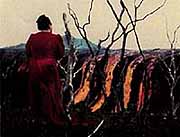

  |
 Types of Lava Types of LavaVolcanoes come in many shapes and sizes. Volcanic eruptions may be quiet outflows of lava which are so peaceful that one can stand close enough to toss in pebbles (or leis; see figure) or so explosively violent that they blow mountains apart and blast everything within a hundred miles to smithereens (not recommended for close observation). Both the shapes of volcanoes and the violence of volcanic eruptions depend on the same rather mundane thing: the physical properties of erupting lavas. Photo: Courtesy of Fabman, Life Magazine. The two most important properties of lava are its viscosity, and the amount of gases dissolved in the liquid rock. Let's look at each of these separately.
[ Home ] [ Teacher Pages ] [ Modules & Activities ] |
HTML code by Chris Kreger
Maintained by ETE Team
Last updated November 10, 2004
Some images © 2004 www.clipart.com
Privacy Statement and Copyright © 1997-2004 by Wheeling Jesuit University/NASA-supported Classroom of the Future. All rights reserved.
Center for Educational Technologies, Circuit Board/Apple graphic logo, and COTF Classroom of the Future logo are registered trademarks of Wheeling Jesuit University.